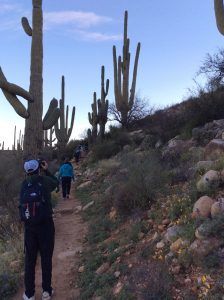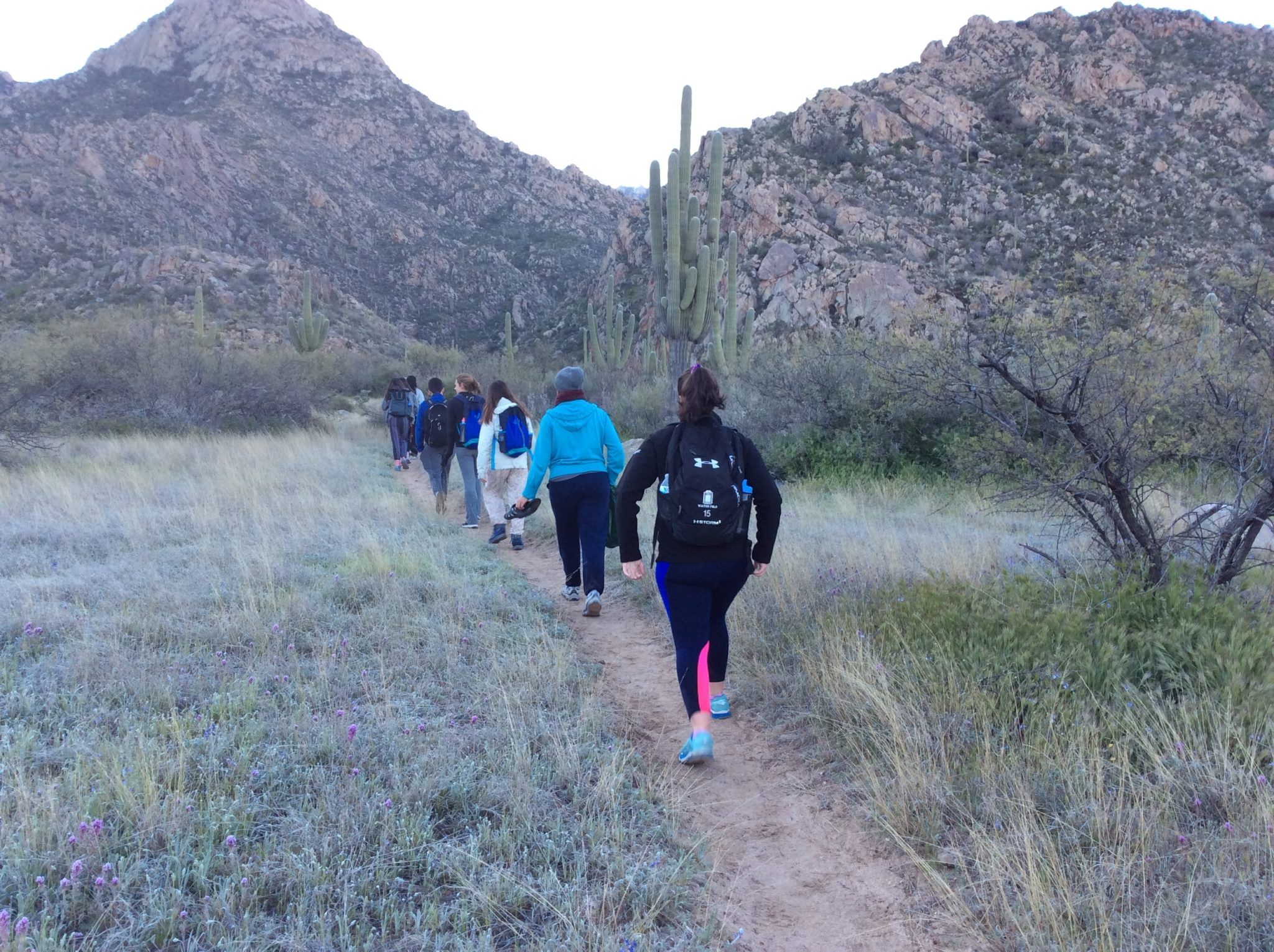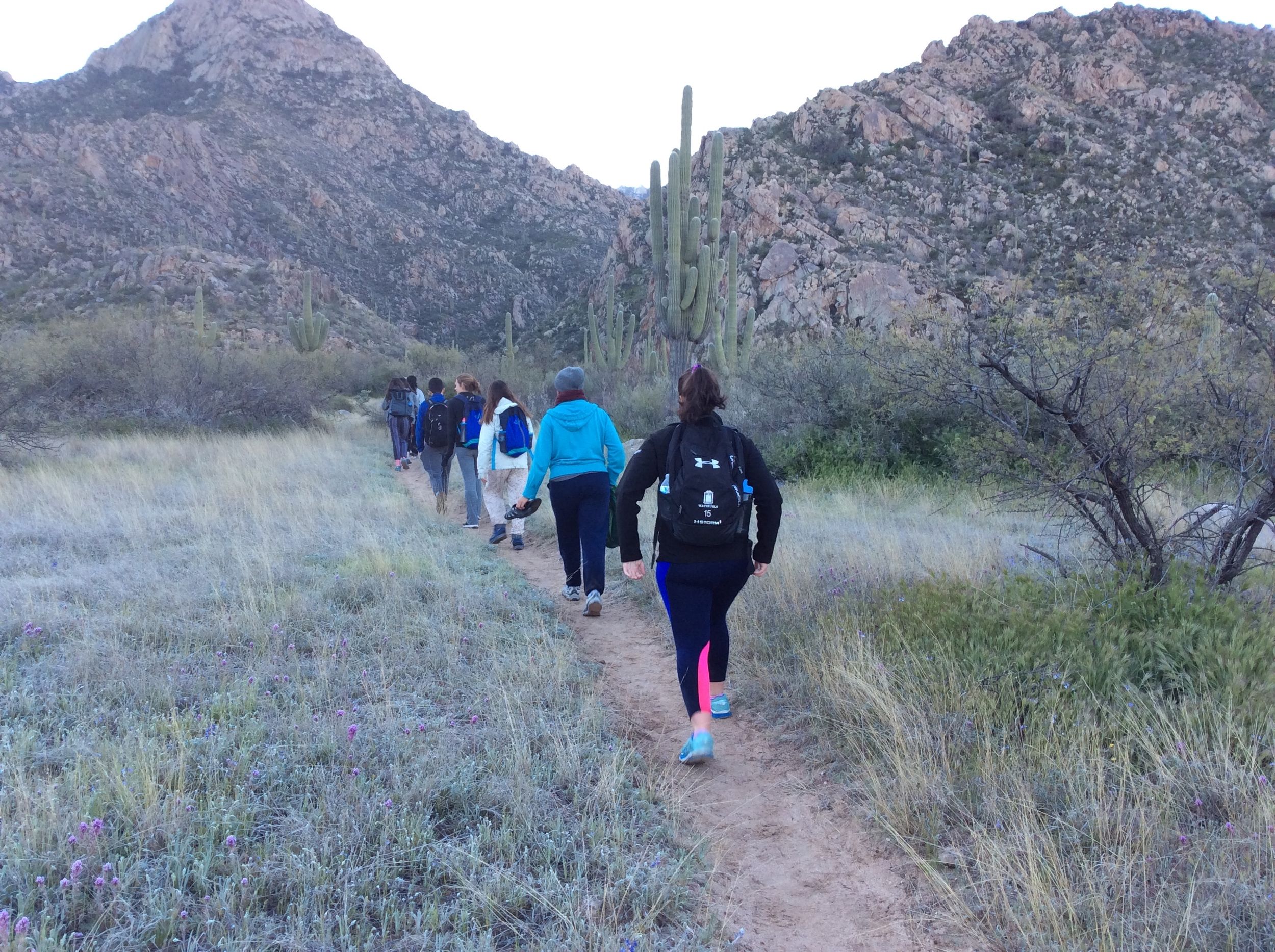Orlee Marini-Rapoport (’19) writes about her hike in the desert, as she reflects on how the experiences of this trip have shaped her understanding of immigration.
 Barefoot and shivering in multiple layers of clothing, we crossed three ice cold streams before sunrise yesterday in the Catalina State Park in Arizona. We were surrounded by saguaro cacti in an area of the desert that’s considered “easy hiking” — level, sandy, and cool. But at that moment, the five-mile hike we had embarked on seemed so difficult. Our feet became increasingly numb as we walked in between the streams, dreading the next crossing. A few people noticed that it felt as if we were walking on burning hot sand. I personally felt as if I were walking on tiny shards of glass as my feet adjusted to the water temperature, then attempted to readjust to the outside temperature, and then attempted to readjust to the water temperature again. This was an “easy” trail through the desert that provided amazing photos of the sunrise and a waterfall, yet we were struck by how difficult and uncomfortable it was. On the hike, I was reminded that the desert in Arizona isn’t just unbearably hot: it’s also freezing cold with rocky, steep trails (or no trails at all), and the conditions change all the time. One night it can be 20 degrees and just a few days later it might be 80 degrees. We were there for only two hours or so, with plenty of water, an abundance of warm clothing, and full stomachs. And we ended our hike on our warm, comfortable bus.
Barefoot and shivering in multiple layers of clothing, we crossed three ice cold streams before sunrise yesterday in the Catalina State Park in Arizona. We were surrounded by saguaro cacti in an area of the desert that’s considered “easy hiking” — level, sandy, and cool. But at that moment, the five-mile hike we had embarked on seemed so difficult. Our feet became increasingly numb as we walked in between the streams, dreading the next crossing. A few people noticed that it felt as if we were walking on burning hot sand. I personally felt as if I were walking on tiny shards of glass as my feet adjusted to the water temperature, then attempted to readjust to the outside temperature, and then attempted to readjust to the water temperature again. This was an “easy” trail through the desert that provided amazing photos of the sunrise and a waterfall, yet we were struck by how difficult and uncomfortable it was. On the hike, I was reminded that the desert in Arizona isn’t just unbearably hot: it’s also freezing cold with rocky, steep trails (or no trails at all), and the conditions change all the time. One night it can be 20 degrees and just a few days later it might be 80 degrees. We were there for only two hours or so, with plenty of water, an abundance of warm clothing, and full stomachs. And we ended our hike on our warm, comfortable bus.But so many people who walk through the desert aren’t as lucky. At the Colibri Center for Human Rights and the Red Cross, we learned more about how migrants, oftentimes from Central America, cross the border in the Sonoran Desert to reach the U.S., sometimes after being denied asylum by border patrol. We met with a couple that is personally connected to undocumented people, and they reiterated to us that the vast majority of migrants are looking for safety and security for their children, often leaving war-torn nations. Their children’s lives may have been recently threatened or government corruption may have left the parents unemployed or in danger.
Many migrant families have to cross the border in the harshest area of the desert, where patrols are less likely to find them. These families have traveled an unimaginable distance on foot. They have traveled in unimaginable temperature conditions, extreme hot and cold. They have traveled for well over a month, leaving their home country of Honduras or Guatemala and more. Many will die in this part of the desert. When their bodies are found, the Colibri Center will work to identify the deceased so that their loved ones can be notified. Yesterday, we met Alvaro Enciso, a man who places a wooden cross at every location where a migrant’s body is found in the Sonoran desert.
families have traveled an unimaginable distance on foot. They have traveled in unimaginable temperature conditions, extreme hot and cold. They have traveled for well over a month, leaving their home country of Honduras or Guatemala and more. Many will die in this part of the desert. When their bodies are found, the Colibri Center will work to identify the deceased so that their loved ones can be notified. Yesterday, we met Alvaro Enciso, a man who places a wooden cross at every location where a migrant’s body is found in the Sonoran desert.
 families have traveled an unimaginable distance on foot. They have traveled in unimaginable temperature conditions, extreme hot and cold. They have traveled for well over a month, leaving their home country of Honduras or Guatemala and more. Many will die in this part of the desert. When their bodies are found, the Colibri Center will work to identify the deceased so that their loved ones can be notified. Yesterday, we met Alvaro Enciso, a man who places a wooden cross at every location where a migrant’s body is found in the Sonoran desert.
families have traveled an unimaginable distance on foot. They have traveled in unimaginable temperature conditions, extreme hot and cold. They have traveled for well over a month, leaving their home country of Honduras or Guatemala and more. Many will die in this part of the desert. When their bodies are found, the Colibri Center will work to identify the deceased so that their loved ones can be notified. Yesterday, we met Alvaro Enciso, a man who places a wooden cross at every location where a migrant’s body is found in the Sonoran desert.If families are instead lucky enough to be granted very temporary asylum status, they will face detention centers. On Thursday, we volunteered at a shelter, a former monastery. After more than five days in the detention centers, the families are relieved to be moved to this shelter, this safe place. This place is where we had the opportunity to work with asylum seekers, recently released from the immigrant detention centers, where they were quite literally locked in cages. Some members of our group served as translators for the medical doctors who were examining some of the children. Other members of our group prepared the cots for dormitory, and other members, like myself, handed out food. At the detention centers, the migrants had been served American processed food — cheese and crackers — which often makes the children sick because they’ve never eaten something so processed before. Now, the children reached for the orange slices in my hand and smiled, asking for water. I handed the parents orange slices as well, but they instinctively gave theirs to their children. They have given, and continue to give, everything so that their children can have the best life possible. They are safe for now. They have endured the detention camps to reach this safe place. But their journey is not over yet.
This trip has deepened my understanding of immigration at the border. This isn’t a political issue. This is a humanitarian crisis.


